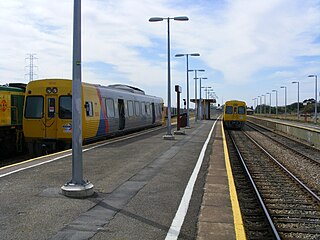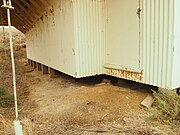
Adelaide railway station is the central terminus of the Adelaide Metro railway system. All lines approach the station from the west, and it is a terminal station with no through lines, with most of the traffic on the metropolitan network either departing or terminating here. It has nine below-ground platforms, all using broad gauge track. The station is located on the north side of North Terrace, west of Parliament House.

The rail network in Adelaide, South Australia, consists of four lines and 89 stations, totalling 132 km (82 mi). It is operated by Keolis Downer under contract from the Government of South Australia, and is part of the citywide Adelaide Metro public transport system.

The Port River is part of a tidal estuary located north of the Adelaide city centre in the Australian state of South Australia. It has been used as a shipping channel since the beginning of European settlement of South Australia in 1836, when Colonel Light selected the site to use as a port. Before colonisation, the Port River region and the estuary area were known as Yerta Bulti by the Kaurna people, and used extensively as a source of food and plant materials to fashion artefacts used in daily life.

The first railway in colonial South Australia was a line from the port of Goolwa on the River Murray to an ocean harbour at Port Elliot, which first operated in December 1853, before its completion in May 1854.

The SteamRanger Heritage Railway is a 82 kilometres long 1600 mm broad gauge tourist railway, formerly the Victor Harbor railway line of the South Australian Railways (SAR). It is operated by the not-for-profit South Australian Division of the Australian Railway Historical Society. As the last operating non-suburban line of the former broad-gauge network, on which Australia's first public railway was opened, the line and its associated rail assets have high historical significance.

Port Broughton is a small South Australian town located at the northern extent of the Yorke Peninsula on the east coast of Spencer Gulf. It is situated about 170 km north-west of Adelaide, and 56 km south of Port Pirie. At the 2016 census, the town of Port Broughton had a population of 1,034.

The Gawler line, also known as the Gawler Central line, is a suburban commuter railway line in the city of Adelaide, South Australia. The Gawler Line is the most frequent and heavily patronised line in the Adelaide rail network.

Dry Creek railway station is located on the Gawler line. Situated in the inner northern Adelaide suburb of Dry Creek, it is 10.6 kilometres (6.6 mi) from Adelaide station.

Dry Creek is a mostly industrial suburb north of Adelaide, containing significant wetlands. A substantial area was devoted to salt crystallisation pans until 2014, with plans to redevelop the site for housing.

The Barker Inlet is a tidal inlet of the Gulf St Vincent in Adelaide, South Australia, named after Captain Collet Barker who first sighted it in 1831. It contains one of the southernmost mangrove forests in the world, a dolphin sanctuary, seagrass meadows and is an important fish and shellfish breeding ground. The inlet separates Torrens Island and Garden Island from the mainland to the east, and is characterised by a network of tidal creeks, artificially deepened channels, and wide mudflats. The extensive belt of mangroves are bordered by samphire saltmarsh flats and low-lying sand dunes.

The National Railway Museum, Port Adelaide, South Australia is the largest railway museum in Australia. More than 100 major exhibits, mainly from the South Australian Railways (SAR) and Commonwealth Railways and their successor, Australian National, are displayed at its 3.5 hectares site. A very large archival collection of photographs of those railways and records created by them is also managed by the museum. The museum is operated with a large number of volunteers.

The Northfield railway line was a railway in northern Adelaide running Dry Creek and Northfield. The line branched east from the Gawler railway line just north of Dry Creek station. In earlier years, it saw mixed freight including livestock in and meat out of the Gepps Cross abattoirs and sale yards. In its later years, it was operated as part of the metropolitan passenger rail network and served three stations: Cavan, Pooraka, and Northfield.

Gillman is a predominantly industrial north-western suburb of Adelaide, in the City of Port Adelaide Enfield. It is located within the federal Division of Hindmarsh and the state electoral district of Port Adelaide.
Southport is an outer rural locality in Darwin. It is based on the site of the abandoned Town of Southport, a thriving river port during the Pine Creek gold rush of the 1870s. It is located at the junction of the Blackmore and Darwin Rivers.

The GM class are a class of diesel locomotives built by Clyde Engineering, Granville for the Commonwealth Railways in several batches between 1951 and 1967. As of January 2014, some remain in service with Aurizon and Southern Shorthaul Railroad.

The Truganina Explosives Reserve was a secure storage facility near Altona in the Australian state of Victoria. It was in operation from 1901 to 1962 to store mainly civilian explosives for mining and construction. The camp included several storage sheds and a jetty, which were connected by a narrow-gauge horse-drawn tramway. Like the Dry Creek explosives depot at Port Adelaide, the site is a testimony to history and transportation in Australia.
Transport in South Australia is provided by a mix of road, rail, sea and air transport. The capital city of Adelaide is the centre to transport in the state. With its population of 1.4 million people, it has the majority of the state's 1.7 million inhabitants. Adelaide has the state's major airport and sea port.

The North Arm Powder Magazine near Port Adelaide, South Australia, was from 1858 to 1906 a secure storage facility for dynamite and gelignite used in the construction, mining and quarrying industries.

Eighteen South Australian Railways K class (broad-gauge) locomotives were built by Beyer, Peacock and Company for the South Australian Railways (SAR) between 1878 and 1884. Despite having a fundamental design flaw that affected their original role as light-line passenger locomotives, they eventually performed shunting duties exclusively. They operated for six decades.

Four South Australian Railways L class broad-gauge locomotives with a 4-4-0 wheel arrangement were built by Beyer, Peacock and Company in 1879 and entered service in March–April 1880. They were condemned in 1928 and 1931, and were subsequently scrapped.






























